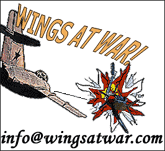Aircraft Of The Western Front 1917-18
![]()
In 1909 the French created the first force of combat aircraft, the Aéronautique Militaire, though not an independent force until 1933. In total, France produced 68,000 aeroplanes during the war and lost 53,000. The British built 55,000 loosing 33,000 and the Germans produced 47,000 with 27,000 lost. Less then half the losses were due to combat.
Most aeroplanes of this period were biplanes. An aeroplane with two wings can lift around 20% more than a monoplane of the same size, which in turn gives greater manoeuverability. The box-like structure of the wings also added strength (enabling more extreme manoeuvres) though at a cost of lower speed due to the increased drag of the connecting bracing.
The men that flew these flimsy machines knew their chances of survival were slim. There were no parachutes, fuel tanks were unprotected, wings were fabric covered and stiffened with flammable dope, engine reliability was problematical at best and wings were prone to collapse. Plus, not withstanding the occasional show of chivalry, the enemy was hell-bent on shooting you down.
RFC doctrine was aggressive with pilots encouraged to penetrate enemy air space as deep as possible in order to overawe the Germans. This however, suited the Germans; "letting the customer come into the shop". In 1918 the Royal Air Force was formed by amalgamating the RFC and RNAS. It included the Independent Force, formed to provide an autonomous bombing fleet with a strength of around fifty O/400s, seventy five DH.4s and DH.9s and a squadron of Camels.
The Germans, outnumbered on average by four to three, had to constantly improve their aeroplanes to stay in the game. In general they managed to keep the technological edge, and bar the odd period when one side or the other held sway, the opposing air forces tended to cancel each other out.
When the USA entered the war in April 1917 its Aviation Section had little more than a couple of dozen trained pilots and no combat-worthy planes. For the rest of the war it had to rely on British and French aeroplanes, concentrating on tried and tested, mainly French, types.
Belgian modernised and expanded their air force so that by 1918 it comprised three squadrons of fighters, three of reconnaissance and one of bombers. Due to the tiny size of the force it tended to concentrate on reconnaissance. King Albert was an observer on a reconnaissance mission in July 1917. By then the Belgians were flying 120 sorties each day. The Belgian ace Willy Coppens was the top scoring balloon buster of WW1.
The pace of aeroplane development between 1914 and 1918 was almost bewildering. Most new types didn't amount to much and were quickly discarded leaving the following types to make up the bulk of aeroplanes operating over the Western Front in 1917 and 1918;
BRITISH
Sopwith Camel
Developed from the popular Pup and Triplane, the Camel, whose actual official designation was Sopwith F.1, was utterly unlike its graceful well behaved predecessors.
Named because of the hump over the breeches of its guns (the first British scout to be armed with two machineguns firing through the propeller) it exhibited all the temperamental cussedness of its namesake. It was not an aeroplane for the inexperienced or faint hearted but Camels shot down more enemy aircraft than any other type. One Camel pilot said "She left you with three choices - Victoria Cross, Red Cross or Wooden Cross".
With pilot, armament, fuel and engine concentrated at the front it could out-turn virtually any other aeroplane. This was especially true to the right, aided by the action of its powerful rotary engine in which the whole cylinder block turned clockwise, as the pilot looked, round the crankshaft, unlike the later radial engine with turning crankshaft and fixed block.
With the introduction of the faster Fokker D.VII the Camel was used increasingly in the ground attack role. By 1918 there were 13 camel squadrons and by war's end around 5,500 had been built. The top scoring ace that flew Camels was the Canadian RNAS pilot Raymond Collishaw. Another Canadian, William Barker, shot down 46 enemy aeroplanes and balloons in the same Camel (number B6313) and of course Biggles had many of his best adventures in a Camel.
ISA13
SE.5a
The Camel and the SE.5a were the team that finally wrested air superiority from the Germans during the last year of the war, both being introduced in the early summer of 1917. Its large streamlined inline engine made it faster than its stablemate, and though not as manoeuverable it was much easier and safer to fly.
Typically for the government run Royal Aircraft Factory it was a conservative design. For example the second machinegun was mounted on the top wing, though some pilots preferred this as it was able to swivel upwards. 5,000 were built and it was the mount of many of the RFC/RAF top ranking aces such as James McCudden, Mick Mannock and Albert Ball. The latter was at first reluctant to give up his agile Nieuport but scored 17 of his 44 victories in the SE.5a.
ISA10
Sopwith Triplane
More or less a Sopwith Pup with an extra wing . The third wing added strength and meant that some of the drag inducing bracing wires could be dispensed with. The 'Tripe' was only operated by six squadrons of the RNAS and first saw action after the debacle of 'Bloody April'. Though extremely nimble it was only armed with a single machinegun and the immanent and superior Camel meant that only 150 were built.
The most famous proponents of the Triplane was the Canadian Black Flight of Naval Ten led by Collishaw.
ISA8
Bristol F.2B
The F.2B was conceived as a reconnaissance plane that could handle enemy scouts but evolved into a fighter that could also do reconnaissance. Armed with a single machine gun firing through the propeller and a flexible one for the observer. Unfortunately its baptism of fire during Bloody April was a complete disaster and it wasn't until improvements to engine, wing, armament and tactics that the 'Bristfit' came into its own. Around a dozen squadrons fought on the Western Front and a total of 3,000 were built.
ISA11
RE.8
The two-seat RE.8 owed its prominence more to the fact that it was produced by the government run Royal Aircraft Factory than any inherent excellence of design. Though inferior to the rival Armstrong Whitworth FK.8 over 4,000 'arry Tates' were built, more than double the number of 'Big Acks'.
Like its predecessor the BE.2c it was designed for stability rather than manoeuverability, "more like flying a steam roller than an aeroplane" as one pilot put it, and it consequently suffered badly during Bloody April. In experienced hands however it proved to be a competent enough reconnaissance plane.
ISA12
DH.4 & DH.9
Known by it's crew as the 'Flaming Coffin' due to the fuel tank being positioned between pilot and observer, the de Havilland bomber was endowed with tremendous performance figures thanks to its powerful Rolls Royce Eagle inline engine. By war's end it equipped 25 British and 13 US squadrons.
The DH.4 Could carry 200 kg of bombs over a considerable distance and was usually armed with a fixed gun forward and a flexible one for the observer. The Americans tended to operate in much larger formations than the British and one of the more spectacular raids was the attack by 200 DH.4s on a German force during the Meuse-Argonne battle. This was led by Billy Mitchell who later found fame as America's foremost bomber proponent.
The DH.9 moved the crew closer together and was armed with twin flexible machineguns for the observer. Designed for mass production, the RAF hoped to field nearly 200 squadrons, most were fitted with an assortment of inferior engines.
ISA14
Handley Page O/400
An improved version of the massive twin-engine O/100, originally designed for the Admiralty as a "bloody paralyser". The 30m (100 ft) wingspan was the same as a Lancaster bomber.
The O/100's first bombing raid, crewed by the RNAS, was made in March 1917. Targets included bridges, railways, troop concentrations and other strategically important sites immediately behind the front line. Later on industrial targets in Germany were hit. By the autumn of 1918 raids could include upwards of 40 aircraft (some 20% of the total then in service), though most O/400s operated in units of one to three.
It could carry a bombload of 2,000lbs or a single 1,650lb (748kg) bomb, the heaviest bomb used by the RAF in WW1. The crew of three - pilot, observer and gunner - had twin machinegun mountings fore and aft and a single gun firing through a tunnel covering the blind spot below the aeroplane. Sixty-nine O/400s were lost during the war.
ISA20
FRENCH
Nieuport 17
With a large top wing for lift and a smaller lower wing for reduced drag the Nieuport was one of the nippiest aeroplanes of the mid war period, though in a steep dive the wings had a tendency to collapse. Developed from the Nieuport 11 Bébé the 17 was flown by many of the top Allied aces; British and Belgian as well as French.
The Nieuport 11's top wing-mounted Lewis gun was changed to a single Vickers firing through the propeller, thought the French navy preferred the earlier arrangement and added a second Lewis on the wing for good measure. It was eventually replaced by SPAD scouts after 4,000 were built.
Nieuport 28
A further development of the Nieuport sesquiplane line, but this time the wings were more equal. It was discarded by the French soon after its introduction in Autumn of 1917 as the engine was unreliable and the wings were said to have a tenancy to loose fabric during sharp manoeuvres. As the American Air Service didn't have any aeroplanes of its own it gratefully accepted the Nieuport 28, though eventually most US squadrons swapped them for the more reliable SPAD.
SPAD VII
Powered by a water-cooled inline engine and first used in small numbers in 1916, it was not until 1917 that a series of problems were resolved allowing a more general distribution. Eventually a total of 5,500 were made. Used by France's most famous unit, the Cicognes (storks), it also saw service with virtually all of the Allied air forces. The all-wood fuselage gave it excellent strength though it lacked the agility of the Nieuports.
Georges Guynemer's SPAD VII in the air museum at Le Bourget is probably the best preserved First World War aeroplane.
SPAD XIII
A development of the VII with an extra machine gun and more powerful engine the SPAD XIII was one of the fastest aeroplanes of the war. The highest scoring Allied ace René Fonk gained many of his kills in a SPAD XIII. On one occasion he shot down three enemy with only 27 bullets.
Introduced at the end of 1917 France finished the war with no less than 81 squadrons of SPAD XIIIs with over 8,000 being built.
Caudron R.11
The twin-engine three-seat Caudron R.11 was designed as a reconnaissance plane able to defend itself. Its performance was such that despite its size it was pressed into service as an escort fighter, in the main supporting Breguet 14s on massed bombing raids. With 5 machine guns (twin-mountings fore and aft and a single gun firing downwards beneath the cockpit) it was very effective in its role. First operational in spring 1917 there were six squadrons of Caudron R11s by the end of the war.
Breguet 14
With the cowling of its large water-cooled inline engine punctured by lines of louvres, the two seat Breguet 14 looked like the SPAD's bigger brother. Like the SPAD it was solidly built. It was the first mass produced aeroplane with a metal frame and had one of the longest working lives of any First World War vintage plane being in service from spring 1917 to 1932.
Extremely versatile; by the end of the war it equipped reconnaissance and bombing squadrons, was used as an ambulance, seaplane and had units attached to army and heavy artillery formations. Armed with a fixed forward-firing machine gun, flexible twin-mounting operated by the observer and up to 300kg of bombs.
Salmson 2A2
Standard French two-seat reconnaissance aeroplane of the last years of the war with over 3,000 being built. Unusual for being powered by a water-cooled radial engine the 2A2 had more conventional identical top and bottom wings and was armed with a fixed forward-firing machine gun and twin flexible machineguns for the observer.
It was well liked for its solid construction though observers complained that their position was placed too far from the pilot leaving them unable to communicate, a fairly common problem in the draughty open cockpits of the period.
GERMAN
Albatros D.V
Despite its sharklike streamlined contours, this up-engined development of the Albatros D.III was not much, if any, of an improvement. Like many aeroplanes of the period it suffered a series of structural failures and had to be judiciously strengthened. First flown in combat just after Bloody April over 1,000 were in service a year later and it soldiered on until the end of the war.
Not withstanding its ordinary perform Albatros D.Vs exhibited probably the most eye-catching array of colour schemes ever seen on an aircraft.
ISA108
Fokker Dr.1 Triplane
Designed to counter the Sopwith Triplane the Dr.1 was probably the most agile aeroplane on the Western Front, though like the Camel it was very tricky to fly. Faulty workmanship led to many Triplanes loosing their top wing and it was grounded for a while soon after becoming operational in the summer of 1917. It had a short operational life, the most in service at any one time being 17, but it was still flown by many of Germany's top aces including Manfred von Richthofen in which he made his last 20 kills.
ISA112
Fokker D.VII
Probably the best fighter of the war. Like the Fokker Dr.1 the Fokker D.VII benefited from a revolutionary wing design incorporating the latest research into aerodynamics. The thicker wing provided greater lift, endowed better manoeuverability and meant it could dispense with the draggy bracing that festooned other aeroplanes of the period. Unlike its three-winged predecessor it was much safer for the novice and its simple fabric covered wood and steel box construction was easy to repair.
Delivered to front line units from April 1918 it eventually made up over 60% of German fighter strength. Famously singled out by a clause in the Armistice demanding the handing over to the Allies of all examples at the end of the war.
ISA110
LFG Rolland C.II
The Walfisch (Whale) was a sleek two-seat reconnaissance aeroplane whose unusual biplane configuration of top wing mounted on the fuselage gave unimpeded upward visibility and a better field of fire for the observer's gun. Unfortunately this configuration made it prone to stalling and it could be difficult to fly. Less than 300 were built and it had been relegated to training duties by the end of the war.
ISA107
Halberstadt CL.II
The CL designation was for smaller two-seaters designed as escort for reconnaissance planes. The Halberstadt CL.II was based on a single-seat fighter and was soon being used as an effective light bomber from 1917. In one very successful attack twenty-four CL.IIs bombed British troops crossing bridges over the Somme and they were very prominent during the German counter-attack at Cambrai.
Unusual for a two-seater the pilot and observer shared a single cockpit. 700 were built.
ISA113
Hannover CL.II
Hannover were the only other company able to produce effective CL types. Like the earlier Halbertsadt the Hannoveraner was designed as an escort plane but operated mainly in the light bomber role, later forming dedicated Schlachtstaffeln ('Battle Flights') for ground attack. The short span biplane tail allowed the observer a better field of fire. It had an endurance of around three and a half hours. Over 400 were built.
The Hannover CL.III was a development of the CL.II with a few minor changes to improve low-level performance.
ISA111
Friedrichshafen G.III
The solidly built twin-engine G.III was a larger version of the G.II that first operated in early 1917. It could carry a bomb load of 1,000 kg (2,200 lbs) for short range tactical raids, half this for longer ranged strategic targets, including Paris and the Channel ports. Being shorter ranged than the Gotha and R series heavy bombers they did not operate over Britain.
Originally armed with a flexible gun fore and aft later versions added an extra machinegun firing through a tunnel in the floor. Around 1,000 were built.
ISA116
Balloons
Balloons were the first aircraft committed to military use and both sides made extensive use of captive kite balloons for artillery spotting and general observation. This made them valuable targets for the enemy so they were always well protected by anti-aircraft guns. They could stay up longer than aeroplanes and given enough time could be winched back to the ground and relative safety if attacked. Even in the air they proved a difficult target to destroy, generally requiring the use of special ammunition. Shooting down a balloon was considered as great a feat as shooting down an aeroplane.
A German balloon company of two balloons required 232 men, 123 horses and 12 gas wagons.
ISA1, 301, 301a, 101, 101a
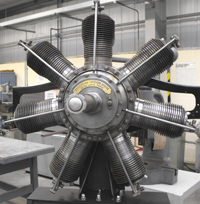
Gnome rotary engine
under restoration
at RAF Cosford
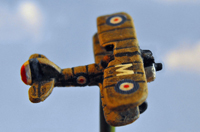
Camel
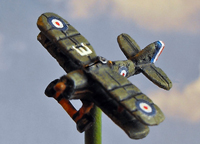
SE.5a
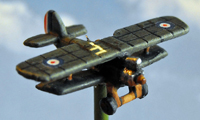
RE.8
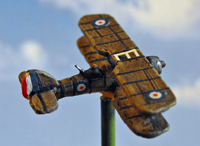
DH.4
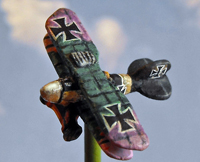
Albatros
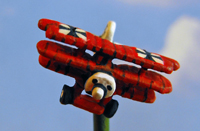
Fokker Dr.1
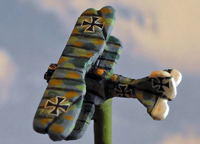
Fokker D.VII
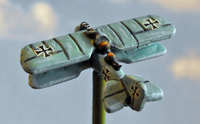
Rolland C.II
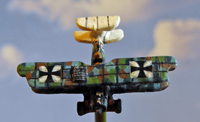
Hannover CL.II
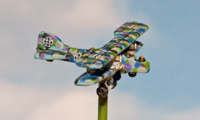
Friedrichshafen G.III
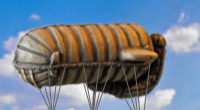
French Caquot Balloon
Click on the links below for more information
